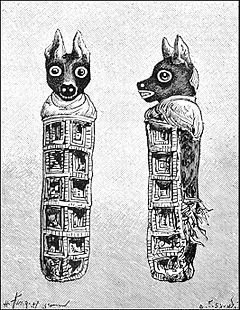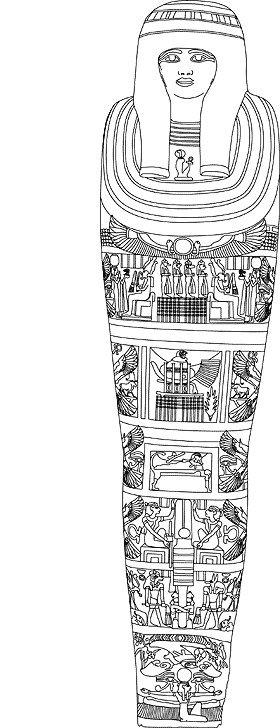
foto de K. Garret
Iufaa era un sacerdote de la XXVII dinastía que sirvió a los dos faraones: Amasis y Samético III, siendo enterrado durante la ocupación del rey Darío I.
Durante las excavaciones realizadas por el equipo checo en el complejo de la pirámide de la V dinastía en Abusar, en la estación correspondiente al año 1998, encontró ese equipo el sepulcro del sacerdote,
Dicho sepulcro tenía una muralla de abobe que le protegía, un foso principal, una cámara funeraria que estaba sellada con las rocas originales.
Cuando abrieron el sarcófago de piedra encontraron otro sarcófago antropoide de basalto. Tuvieron que utilizar un sistema de elevadores para poder alzarlo, ya que la tapa del sarcófago exterior pesaba 24 toneladas alzó, y estaba en el interior de un pozo que estaba a bastante profundidad (25 metros) . Después se vio en el fondo de la tumba el sarcófago interior con los restos del féretro de madera que guardaba a la momia de Iufaa.
En su interior estaba la momia de Iufaa pero el cuerpo estaba bastante dañado debido a las filtraciones de aguas freáticas. También encontraron bastantes objetos funerarios, vasos cerámicos y objetos , vasos canónicos, recipientes para unguentos olorosos , ushatis… Por lo visto habían intentado abrir el sarcófago ladrones de tumbas, pero desistieron y el sarcófago permanecía sellado asi es que todo el ajuar funerario fue encontrado.
Un manto elaborado con cuentas de cerámica esmaltada azul cubría a la momia y la cabeza ,brazos y piernas habían sido recubierta con oro.
El equipo checo sacó la momia de su sarcófago y fue introducida en un ataúd de madera para así transportarla al laboratorio donde iba a ser analizada.
Las radiografía realizadas al cuerpo del sacerdote mostraron que se trataba de un hombre joven que debía tener a la hora de su muerte entre 25-35 años de edad. Tenia problemas odontológicos, artritis y osteoroporosis… sus dolencias le llevaron a una muerte prematura
Aqui tenemos un detella de la decoración de la cámara funeraria con unas vacas danzando
Este es uno de los ushebtis encontrados en su tumba
(fuente foto ksl)
las fotos son del Instituto checo
----------------------------------------------------------------------------------------
Czech Egyptologists Open Shaft Tomb May 27, 1998
by Lyla Pinch Brock and Jaromir Krejci
Sealed sarcophagi in the tomb of Iufaa, an Egyptian priest and palace administrator, were recently opened by Czech archaeologists excavating at Abusir, yielding a wealth of information about burial practices and religious beliefs ca. 525 B.C. It was the first unrobbed shaft tomb to be found in Egypt since 1941. In 1996 a small archaeological team of the Czech Institute of Egyptology at Charles University in Prague directed by Miroslav Verner located the burial chamber at the bottom of a shaft more than 80 feet below the desert floor. The tomb was made of white limestone blocks and had a vaulted roof, also of limestone.
Once inside, the team discovered an enormous white limestone sarcophagus almost filling a small chamber. Around its base were 408 faience ushabtis (statuettes of servants for the next world) and four canopic vessels with human-headed lids, one significantly larger than the others. Wooden furniture was also present, along with stone vessels of various sizes, papyri scrolls, and a considerable quantity of pottery, much of it imported from the Aegean.
In 1998, Verner's architect raised the two-ton sarcophagus lid with jacks, inserting wooden wedges and then blocks of wood along its edges. Inside they found a black-grayish basalt mummiform sarcophagus coated with a layer of earth and potsherds affixed to the lid with plaster. The eyes on the lid were white outlined in black, and the head carved with a beard and lappet headdress. Beneath the lid was a badly preserved wooden coffin. Inside was Iufaa's mummy covered with a net of blue beads. The mummy was removed to a conservation laboratory for examination by Eugen Strouhal, the team's physical anthropologist. Iufaa's face was covered with a death mask made of gilt cartonage and his skull was filled with resin. Strouhal determined that the priest was less than 30 years old at death.
The walls of the tomb and the sarcophagus were covered with texts of the Book of the Dead, a collection of spells to help the soul of the deceased on its journey in the next world. The reliefs in some cases showed extraordinary scenes connected with the ancients' funerary beliefs.
The Czech team clears Neferefre's burial chamber. (© E.C. Brock) [LARGER IMAGE]
Verner's team has also finished excavations of the substructure of Neferefre's pyramid at Abusir. Neferefre (or Raneferef, ca. 2460-2453 B.C.) was a short-lived Dynasty 5 king. Excavators discovered a graffito bearing Neferefre's name while clearing rubble filling the pyramid's core. Remains of large rose granite portcullises and a gabled roof were also uncovered, signs that the king had been buried in funerary apartments typical of royalty of the era. Fragments of the king's red granite sarcophagus were found there, as well as tiny pieces of mummy wrappings and bones, and parts of canopic jars. Notable finds include fragments of the ruler's mummy, all that remained after the plunder of the pyramids. The mummy material has been examined by Strouhal, who believes they may belong to a young man who died in his early twenties, which fits the profile of Neferefre.
Because he died after a reign of perhaps no more than two years, only the first step of Neferefre's pyramid was hastily completed. A layer of pebbles and mud mortar was placed on the surface of the pyramid, and his body was installed in its funerary apartments. In front of the eastern side of the unfinished pyramid, a mud-brick mortuary temple was erected during the reign of the ruler's ancestors. The Czech team's excavation of this temple in the 1980s yielded a papyri temple archive, statuary, stone vessels, mud seals, and faience inlays.
Like other tombs at Abusir (and in the area of Memphis), Neferefre's was probably robbed a few centuries after the king's burial after the collapse of the Old Kingdom. However, the real devastation began in the Ramesside period (ca. 1300 B.C.), when it was robbed for stone to build private tombs in Saqqara. Four-inch-thick slabs were cut from the pyramid's finest limestone, while bigger ashlars were used for later shaft tombs in south Abusir.
27 mayo 1198
http://archive.archaeology.org/online/news/egypt2.html
by Lyla Pinch Brock and Jaromir Krejci
Sealed sarcophagi in the tomb of Iufaa, an Egyptian priest and palace administrator, were recently opened by Czech archaeologists excavating at Abusir, yielding a wealth of information about burial practices and religious beliefs ca. 525 B.C. It was the first unrobbed shaft tomb to be found in Egypt since 1941. In 1996 a small archaeological team of the Czech Institute of Egyptology at Charles University in Prague directed by Miroslav Verner located the burial chamber at the bottom of a shaft more than 80 feet below the desert floor. The tomb was made of white limestone blocks and had a vaulted roof, also of limestone.
Once inside, the team discovered an enormous white limestone sarcophagus almost filling a small chamber. Around its base were 408 faience ushabtis (statuettes of servants for the next world) and four canopic vessels with human-headed lids, one significantly larger than the others. Wooden furniture was also present, along with stone vessels of various sizes, papyri scrolls, and a considerable quantity of pottery, much of it imported from the Aegean.
In 1998, Verner's architect raised the two-ton sarcophagus lid with jacks, inserting wooden wedges and then blocks of wood along its edges. Inside they found a black-grayish basalt mummiform sarcophagus coated with a layer of earth and potsherds affixed to the lid with plaster. The eyes on the lid were white outlined in black, and the head carved with a beard and lappet headdress. Beneath the lid was a badly preserved wooden coffin. Inside was Iufaa's mummy covered with a net of blue beads. The mummy was removed to a conservation laboratory for examination by Eugen Strouhal, the team's physical anthropologist. Iufaa's face was covered with a death mask made of gilt cartonage and his skull was filled with resin. Strouhal determined that the priest was less than 30 years old at death.
The walls of the tomb and the sarcophagus were covered with texts of the Book of the Dead, a collection of spells to help the soul of the deceased on its journey in the next world. The reliefs in some cases showed extraordinary scenes connected with the ancients' funerary beliefs.
The Czech team clears Neferefre's burial chamber. (© E.C. Brock) [LARGER IMAGE]
Verner's team has also finished excavations of the substructure of Neferefre's pyramid at Abusir. Neferefre (or Raneferef, ca. 2460-2453 B.C.) was a short-lived Dynasty 5 king. Excavators discovered a graffito bearing Neferefre's name while clearing rubble filling the pyramid's core. Remains of large rose granite portcullises and a gabled roof were also uncovered, signs that the king had been buried in funerary apartments typical of royalty of the era. Fragments of the king's red granite sarcophagus were found there, as well as tiny pieces of mummy wrappings and bones, and parts of canopic jars. Notable finds include fragments of the ruler's mummy, all that remained after the plunder of the pyramids. The mummy material has been examined by Strouhal, who believes they may belong to a young man who died in his early twenties, which fits the profile of Neferefre.
Because he died after a reign of perhaps no more than two years, only the first step of Neferefre's pyramid was hastily completed. A layer of pebbles and mud mortar was placed on the surface of the pyramid, and his body was installed in its funerary apartments. In front of the eastern side of the unfinished pyramid, a mud-brick mortuary temple was erected during the reign of the ruler's ancestors. The Czech team's excavation of this temple in the 1980s yielded a papyri temple archive, statuary, stone vessels, mud seals, and faience inlays.
Like other tombs at Abusir (and in the area of Memphis), Neferefre's was probably robbed a few centuries after the king's burial after the collapse of the Old Kingdom. However, the real devastation began in the Ramesside period (ca. 1300 B.C.), when it was robbed for stone to build private tombs in Saqqara. Four-inch-thick slabs were cut from the pyramid's finest limestone, while bigger ashlars were used for later shaft tombs in south Abusir.
27 mayo 1198
http://archive.archaeology.org/online/news/egypt2.html












